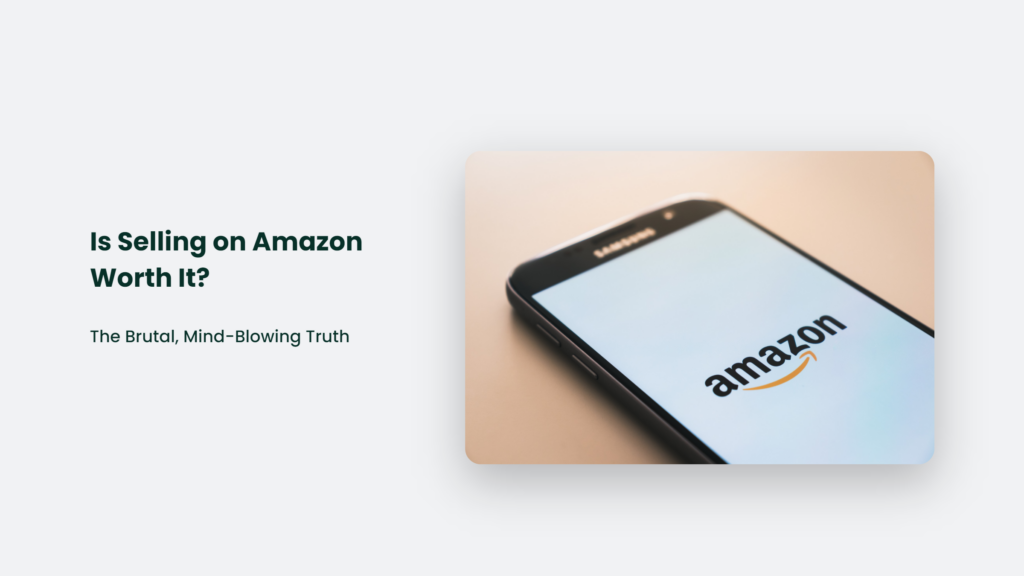

Is Selling on Amazon Worth It? The Brutal, Mind-Blowing Truth

As Seen On
“Is selling on Amazon worth it?” This question echoes through the halls of the internet like the cries of a thousand lost souls, each grappling with the tantalizing prospect of becoming an e-commerce demigod. But, amidst the glittering promises and staggering success stories, it’s time to cut through the noise and ask: does Amazon truly deliver on its irresistible allure?
In this blog post, we’re diving headfirst into the abyss, uncovering the brutal, mind-blowing truth about selling on Amazon. Buckle up, buttercup, because this ride’s about to get bumpy.

The Amazonian Mirage: Shiny, Shimmering, Not-So-Splendid
Before we dive into the nitty-gritty, let’s take a moment to acknowledge the Amazonian elephant in the room: Amazon itself. As the all-powerful behemoth of the e-commerce jungle, it’s no surprise that Amazon has morphed into a digital promised land overflowing with dreams of riches and conquest.
But, as the great philosopher, Jaden Smith once asked, “How can mirrors be real if our eyes aren’t real?” In other words, is Amazon’s success just an illusion, or is it the real deal?
The Good, the Bad, and the Ugly: Pros and Cons of Selling on Amazon
Let’s start by weighing the pros and cons of a modern-day digital Hammurabi.
The Good: A Massive Audience
With over 2.5 billion monthly visitors, Amazon is essentially the Walmart of the internet. This vast sea of potential customers offers sellers a tantalizing opportunity to swim with the big fish, basking in the e-commerce sun like a lazy river otter.
Global Reach:
One of the most significant advantages of selling on Amazon is its massive global reach. As an Amazon seller, you can tap into markets worldwide, expanding your customer base and multiplying your sales potential.
Built-in Trust:
Amazon has established itself as a trusted marketplace, and customers are more likely to buy from Amazon than from an unknown online store. This built-in trust can help you gain credibility and attract customers more easily.
Fulfilment by Amazon (FBA):
FBA is a game-changer for many sellers, allowing them to offload storage, shipping, and customer service to Amazon, freeing up time and resources to focus on growing their business.
The Bad: Competition Galore
If Amazon is a vast sea of opportunity, it’s also chock-full of piranhas ready to eat you alive. With millions of sellers vying for attention, standing out from the crowd can feel like performing a high-wire act with no safety net.
Crowded Marketplace:
With millions of sellers on Amazon, competition can be fierce. It’s challenging to differentiate your products and maintain a competitive edge in the crowded marketplace.
Price Wars:
In a bid to attract customers, sellers often engage in price wars, driving down profit margins and making it difficult for smaller sellers to compete.
Copycat Competitors:
It’s not uncommon for unscrupulous sellers to copy successful products, infringing on intellectual property rights and eating into your market share.
The Ugly: The Fee Monster
Amazon’s fees are like a horrifying, many-tentacled monster that will suck the life out of your profit margins. With referral fees, fulfillment fees, subscription fees, and more, your bank account may start to resemble a barren wasteland.
Referral Fees:
Amazon charges referral fees, which are a percentage of the item’s sale price, typically ranging from 6% to 45%, depending on the product category. These fees can take a significant bite out of your profits.
Fulfilment Fees:
If you choose to use FBA, you’ll be subject to fulfilment fees, which cover the cost of storing, picking, packing, and shipping your products. While FBA offers many benefits, these fees can add up, especially for items with low-profit margins or slow-moving inventory.
Subscription Fees:
Professional sellers are required to pay a monthly subscription fee of $39.99, regardless of their sales volume. It can be a significant expense for smaller sellers or those just starting.
Advertising Costs:
Many sellers invest in Amazon’s advertising platform to stand out in the crowded marketplace, which can be effective but expensive, further cutting profit margins.
Now that we’ve got the lay of the land let’s dive deeper into the murky waters of Amazon selling.
The Numbers Game: Fact-Checking Your Amazon Fantasies

Here’s the thing: Numbers don’t lie. And when it comes to Amazon, some cold, hard stats can put your dreams of e-commerce glory into perspective.
The Big League:
38% of Amazon Sellers Make Over $100K. That’s right – almost two-fifths of Amazon sellers rake in six figures or more. Sounds great, right? But before you start daydreaming about sipping margaritas on your private yacht, let’s look at the flip side.
The Struggle Bus:
62% of Sellers Make Less Than $100K If 38% of sellers live largely, the remaining 62% are grappling with less-than-stellar earnings. The moral of the story? Success on Amazon is far from guaranteed, and it’s essential to approach the platform with eyes wide open.
The Art of War: Strategies for Amazon Success
“You must not fight too often with one enemy, or you will teach him all your art of war.”
– Sun Tzu.
When it comes to conquering the Amazon jungle, strategic planning is the name of the game. You’ll need a few tricks to rise above the cutthroat competition and make your mark. Here are some tactics to help you slay the Amazonian beast:
Pick Your Battles: Choose a Profitable Niche
- Research and Analysis: Dive deep into the vast ocean of Amazon products and market data. Use tools like Jungle Scout, Helium 10, and AMZScout to identify high-demand, low-competition niches. Analyze trends, seasonality, and customer preferences to pinpoint the most promising opportunities.
- Unique Value Proposition: Once you’ve identified a niche, determine how to provide a unique value proposition to your target audience. It could involve offering innovative product features, superior quality, competitive pricing, or exceptional customer service.
- Build a Brand: Create a cohesive and recognizable brand that resonates with your target customers. A strong brand identity can help you stand out and foster customer loyalty.
Bring Out the Big Guns: Optimize Your Listings
- Compelling Product Titles: Craft titles that accurately describe your product while incorporating relevant keywords. A well-constructed title can help improve search rankings and attract potential customers.
- Detailed Descriptions: Provide detailed and informative product descriptions highlighting key features, benefits, and specifications. Break up the text with bullet points and headers for better readability.
- High-Quality Images: Invest in professional-quality product images that showcase your products from multiple angles and in various use cases. High-resolution images with clean backgrounds can help your products stand out and create a positive impression on potential buyers.
- Keyword Research: Use tools like Keyword Scout or Helium 10 to identify your niche’s most relevant and high-performing keywords. Incorporate these keywords strategically into your product listings to improve search visibility and attract more customers.
Fortify Your Castle: Cultivate Stellar Reviews
- Offer Exceptional Customer Service: Respond promptly and professionally to customer inquiries and complaints. A proactive approach to customer service can help resolve issues before they escalate, reducing the chances of negative reviews.
- Encourage Reviews: Follow up with customers after their purchase, thanking them for their business and inviting them to leave a review. While it’s against Amazon’s policies to incentivize reviews, you can still gently remind customers of the importance of their feedback.
- Monitor and Respond to Reviews: Keep a close eye on your reviews and address any negative feedback promptly and professionally. Demonstrating your commitment to customer satisfaction can help mitigate the impact of negative reviews and even encourage customers to revise their initial feedback.
Know Thy Enemy: Spy on Your Competitors
- Analyze Competitor Listings: Examine the product listings of your top competitors to identify their strengths and weaknesses. Take note of what they’re doing well and look for opportunities to improve upon their approach.
- Track Pricing and Promotions: Monitor competitors’ pricing strategies and activities. It can help you stay competitive and anticipate market trends.
- Learn from Reviews: Read the reviews on your competitors’ products to gain insights into customer pain points, preferences, and expectations. Use this information to refine your own product offerings and marketing strategies.
- Keep an Eye on New Entrants: Regularly scan the market for new competitors entering your niche. You can quickly adapt your strategies and maintain your competitive edge by staying informed about new players.
By choosing a profitable niche, optimizing your listings, cultivating stellar reviews, and closely monitoring your competitors, you can maximize your chances of success in the highly competitive Amazon marketplace.
It’s not an easy journey, but with persistence, creativity, and strategic thinking, you can rise above the competition and carve out your slice of the Amazon pie.
The Million-Dollar Question: Is Selling on Amazon Worth It?

And so, we return to the burning question that has haunted us from the start: is selling on Amazon worth it? Like a Zen koan or a particularly baffling episode of Black Mirror, the answer is simple and complex.
On the one hand, selling on Amazon can offer a dazzling array of benefits, from a massive customer base to unparalleled market exposure. On the other hand, it’s a dog-eat-dog world where competition is fierce, fees are brutal, and success is far from guaranteed.
Ultimately, the decision to sell on Amazon is deeply personal, influenced by your individual goals, risk tolerance, and appetite for adventure.
So, as you ponder the question, remember the wise words of the great philosopher Plato: “The unexamined life is not worth living.” (Or, in the context of Amazon: “Do your research, folks.”)
Frequently Asked Questions:
How much does it cost to start selling on Amazon?
While it’s possible to start selling on Amazon for as little as a few hundred dollars, most experts recommend setting aside at least $2,000-$5,000 to cover initial inventory and advertising costs.
What’s the best way to find profitable products to sell on Amazon?
Research, research, and more research. Use tools like Jungle Scout, Helium 10, and AMZScout to help you identify high-demand, low-competition products in niche markets.
How do I deal with Amazon’s fees and still make a profit?
Keeping a close eye on your profit margins is crucial. Factor in Amazon’s fees when determining your product pricing and continually look for ways to optimize your listings and reduce costs. Consider using tools like the Amazon FBA calculator to help you stay on top of your finances.
Can I still succeed on Amazon even if I’m not based in the US?
Absolutely! Amazon has a global reach, and many international sellers find success on the platform. Just be prepared to navigate additional logistics, such as currency conversions, taxes, and shipping.
How can I stay ahead of the competition on Amazon?
Continuously monitor your market, optimize your listings, invest in advertising, and provide exceptional customer service. Adaptability and perseverance are the keys to staying ahead in the fast-paced world of Amazon selling.
In Conclusion: The Amazonian Verdict
So, is selling on Amazon worth it? As we’ve discovered, the answer is a beautifully maddening mix of “yes,” “no,” and “it depends.” While the potential rewards are undeniably alluring, the path to Amazon’s success is fraught with challenges, pitfalls, and the ever-present spectre of competition.
The bottom line? If you’re willing to put in the time, effort, and strategic planning necessary to succeed, Amazon can be a life-changing opportunity. But if you’re looking for an easy, get-rich-quick scheme, you might want to keep searching. In the words of the immortal Ferris Bueller, “Life moves pretty fast.
You could miss it if you don’t stop and look around occasionally.” So, take a moment to examine your goals, assess your risk tolerance, and decide whether the Amazonian jungle is the right place for your e-commerce adventure.
And with that, dear reader, we’ve reached the end of our perilous journey through the wilds of Amazon selling. We hope you’ve found this exploration enlightening, entertaining, and perhaps even life-changing.
Until next time, happy selling, and may the Amazon gods smile upon your digital endeavours.
Konger
Up until working with Casey, we had only had poor to mediocre experiences outsourcing work to agencies. Casey & the team at CJ&CO are the exception to the rule.
Communication was beyond great, his understanding of our vision was phenomenal, and instead of needing babysitting like the other agencies we worked with, he was not only completely dependable but also gave us sound suggestions on how to get better results, at the risk of us not needing him for the initial job we requested (absolute gem).
This has truly been the first time we worked with someone outside of our business that quickly grasped our vision, and that I could completely forget about and would still deliver above expectations.
I honestly can't wait to work in many more projects together!
Disclaimer
*The information this blog provides is for general informational purposes only and is not intended as financial or professional advice. The information may not reflect current developments and may be changed or updated without notice. Any opinions expressed on this blog are the author’s own and do not necessarily reflect the views of the author’s employer or any other organization. You should not act or rely on any information contained in this blog without first seeking the advice of a professional. No representation or warranty, express or implied, is made as to the accuracy or completeness of the information contained in this blog. The author and affiliated parties assume no liability for any errors or omissions.

